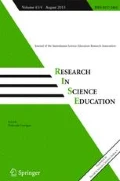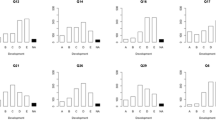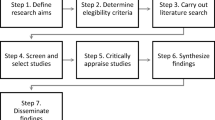Abstract
This paper presents comparative questionnaire data from three different samples of Australian high school students in an attempt to see if anything has changed in relation to how they perceive the science they experience in the compulsory years of secondary school (grades 7–10). Questionnaire data were obtained from 1,585 high school students in 2011 and 2,016 students in 2005 and findings are compared with those reported in a national report (Goodrum et al. 2001). Results show significant increases in the frequency with which students report that their science teacher takes notice of their ideas and in the use of computers and the Internet. There have also been changes regarding the rapid provision of feedback, the use of understandable language by teachers and the contextualisation of the new work in terms of work already covered. Little appears to have changed, however, in relation to the teacher-directed pedagogies employed to teach science where there appears to be a higher incidence of copying notes and fewer opportunities for students to investigate topics in which they are interested. The findings suggest that while there have been some positive changes, there are still many students who indicate that the science they experience in secondary school is irrelevant to their everyday life and to their future. It seems that the curiosity and wonder one would hope is associated with studying science is missing for a large proportion of students. It is clear that further actions need to be undertaken to transform this continuing situation.
Similar content being viewed by others
References
Ainley, J., Kos, J., & Nicholas, M. (2008). Participation in science, mathematics and technology in Australian Education: research monograph no 63. Melbourne: Australian Council for Education Research.
Australian Academy of Science (2010). Science by doing: engaging students with science. http://www.science.org.au/sciencebydoing/index.html. Accessed May 2012
American Association for the Advancement of Science (AAAS). (1990). Science for all Americans: project 2061. New York: Oxford University Press.
Australian Science Teachers Association (ASTA). (1985). Science in Australian schools: today’s problems and tomorrow’s challenges. Canberra: Australian Science Teachers Association.
Australian Academy of Technological Sciences and Engineering. (2002). The teaching of science and technology in Australian primary schools: a cause for concern. Victoria: Australian Academy of Technological Sciences and Engineering.
Barmby, P., Kind, P. M., & Jones, K. (2008). Examining changing attitudes in secondary school science. International Journal of Science Education, 30(8), 1075–1093.
Braund, M., & Driver, M. (2005). Pupils’ perceptions of practical science in primary and secondary school: implications for improving progression and continuity of learning. Educational Research, 47(1), 77–91.
Cleaves, A. (2005). The formation of science choices in secondary school. International Journal of Science Education, 27(4), 471–486.
Committee for the Review of Teaching and Teacher Education (CRTTE). (2003). Australia's teachers: Australia's future advancing innovation, science, technology and mathematics agenda for action. Canberra: Department of Education, Science and Training.
Danaia, L., McKinnon, D. H., Parker, Q. A., Fitzgerald, M. F., Stenning, P. (2012). Space to grow: LCOGT.net and improving science engagement in schools. Astronomy Education Review 11(1): 010106.
Dekkers, J., & De Laeter, J. (2001). Enrolment trends in school science education in Australia. International Journal of Science Education, 23(5), 487–500.
Drury, C., & Allen, A. (2002). Task force on the physical sciences: report and recommendations. Department of Education and Science, Ireland. http://www.sciencetaskforce.ie/. Accessed September 2005
Duschl, R. A., Schweingruber, H. A., & Shouse, A. W. (Eds.). (2007). Taking science to school: learning and teaching science in grades K-8. A research report for the Committee on Science Learning, Kindergarten through Eighth Grade. Washington, DC: The National Academies Press.
Fensham, P. J. (1985). Science for all: a reflective essay. Journal of Curriculum Studies, 17(4), 415–435.
Gaur, A. S., & Gaur, S. S. (2007). Statistical methods for practice and research: a guide to data analysis using SPSS (2nd ed.). Thousand Oaks: SAGE.
Gibbs, W. W., & Fox, D. (1999). The false crisis in science education. Scientific American, 87–92.
Goodrum, D., Hackling, M., & Rennie, L. (2001). The status and quality of teaching and learning of science in Australian schools. Canberra: Department of Education, Training and Youth Affairs.
Goodrum, D., & Rennie, L. (2007). Australian school science education national action plan 2008–2012. Canberra: Department of Education Science and Training.
Goodrum, D., Druhan, A., & Abbs, J. (2012). The status and quality of year 11 and 12 science in Australian schools. Canberra: Australian Academy of Science.
Hackling, M. W., Goodrum, D., & Rennie, L. J. (2001). The state of science in Australian secondary schools. Australian Science Teachers Journal, 47(4), 6–17.
Harris, K. L., Jensz, F., & Baldwin, G. (2005). Who’s teaching science? Meeting the demand for qualified science teachers in Australian secondary schools. Melbourne: Centre for the Study of Higher Education.
International Bureau for Education. (2001). Science education for contemporary society: problems, issues and dilemmas. Geneva: International Bureau for Education, UNESCO.
Johnson, B., & Christensen, L. (2004). Educational research: quantitative, qualitative, and mixed approaches (2nd ed.). Boston: Allyn and Bacon.
Krogh, L., & Thomsen, P. (2005). Studying students' attitudes towards science from a cultural perspective but with a quantitative methodology: border crossing into the physics classroom. International Journal of Science Education, 27(3), 281–302.
Lawrance, G. A., & Palmer, D. H. (2003). Clever teachers, clever sciences: preparing teachers for the challenge of teaching science, mathematics and technology in 21st century Australia. Canberra: Department of Education, Science and Training.
Lyons, T. (2006). Different countries, same science classes: students’ experiences of school science in their own words. International Journal of Science Education, 28(6), 591–613.
Lyons, T., & Quinn, F. (2010). Choosing science: understanding the declines in senior high school science enrolments. Research report to the Australian Science Teachers Association (ASTA). University of New England, Australia: National Centre of Science, ICT and Mathematics Education for Rural and Regional Australia (SiMERR Australia).
McKinnon, D. H. (2005). The eye observatory remote telescope project: practical astronomy for years 7, 8 and 9. A research and development report prepared for the Department of Education, Science and Training (DEST). Canberra: DEST.
Millar, R., & Osborne, J. (1998). Beyond 2000: science education for the future (The report of a seminar series funded by the Nuffield Foundation). London: King’s College London, School of Education.
Murphy, C., & Beggs, J. (2003). Children’s perceptions of school science. School Science Review, 84(308), 109–116.
Osborne, J., & Collins, S. (2000). Pupils’ and parents’ views of the school science curriculum. London: King’s College London.
Simpson, R. D., & Oliver, J. S. (1990). A summary of major influences on attitude toward achievement in science among adolescent students. Science Education, 74(1), 1–18.
SISA (Simple Interactive Statistical Analysis) (2012). Bonferroni. http://www.quantitativeskills.com/sisa/calculations/bonhlp.htm. Accessed 25 May 2012.
Tytler, R. (2007). Re-imagining science education: engaging students in science for Australia’s future. Camberwell: Australian Council for Educational Research.
Tytler, R., Osborne, J., Williams, G., Tytler, K., & Cripps Clark, J. (2008). Engagement in STEM across the primary–secondary school transition: opening up pathways. Canberra: Australian Department of Education, Employment and Workplace Relations.
Acknowledgments
We acknowledge the three projects from which the student data are drawn: Space to Grow Australian Research Council Linkage Grant (grant number: LP0989264); The Eye Observatory Remote Telescope Project: Practical Astronomy for Years 7, 8 and 9—funded by the Department of Education, Science and Training; and, The Status and Quality of Teaching and Learning Science in Australian Schools- funded by the Department of Education, Training and Youth Affairs. We also thank each of the jurisdictions, the schools, the teachers and the students involved in this research.
Author information
Authors and Affiliations
Corresponding author
Rights and permissions
About this article
Cite this article
Danaia, L., Fitzgerald, M. & McKinnon, D. Students’ Perceptions of High School Science: What has Changed Over the Last Decade?. Res Sci Educ 43, 1501–1515 (2013). https://doi.org/10.1007/s11165-012-9318-x
Published:
Issue Date:
DOI: https://doi.org/10.1007/s11165-012-9318-x




